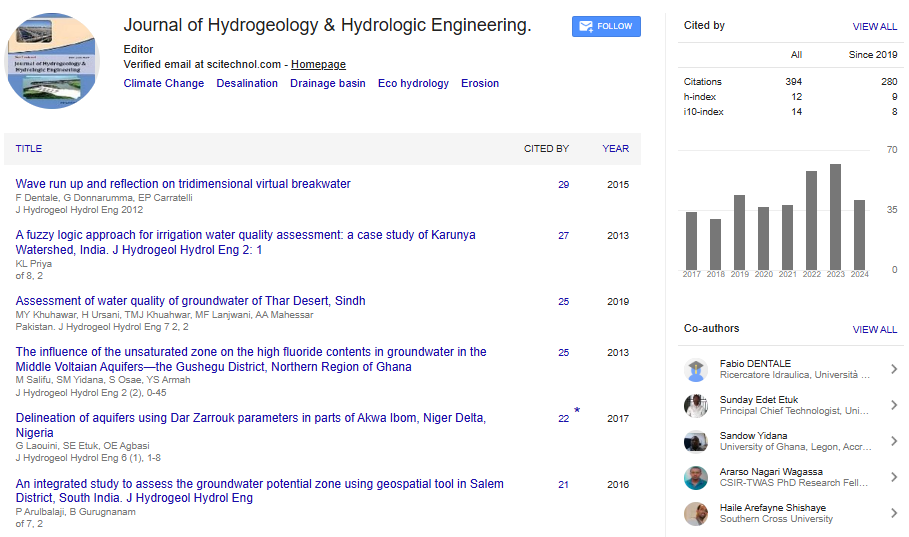Perspective, J Hydrogeol Hydrol Eng Vol: 13 Issue: 3
Flood Hazard Forecasting: An Essential Tool for Disaster Preparation
Stefan Doring*
1Department of Geography, The University of Burdwan, West Bengal, India
*Corresponding Author: Stefan Doring,
Department of Geography, The University
of Burdwan, West Bengal, India
E-mail: dorings48@gmail.com
Received date: 27 May, 2024, Manuscript No. JHHE-24-144600;
Editor assigned date: 30 May, 2024, PreQC No. JHHE-24-144600 (PQ);
Reviewed date: 13 June, 2024, QC No. JHHE-24-144600;
Revised date: 21 June, 2024, Manuscript No. JHHE-24-144600 (R);
Published date: 28 June, 2024, DOI: 10.4172/2325-9647.1000321
Citation: Doring S (2024) Flood Hazard Forecasting: An Essential Tool for Disaster Preparation. J Hydrogeol Hydrol Eng 13:3.
Description
Floods are among the most destructive natural disasters, affecting millions of people worldwide every year. The ability to forecast flood hazards accurately is essential for mitigating their impact, saving lives, and reducing economic losses. This article explores the importance of flood forecasting, the methods used, and the challenges faced in predicting flood events. Flood forecasting plays a vital role in disaster preparedness and response. Accurate forecasts provide early warnings that enable communities to take preventive measures, such as evacuations and the implementation of flood defenses. By predicting the timing, location, and severity of floods, authorities can better allocate resources and coordinate emergency response efforts.
Early warning systems, bolstered by reliable flood forecasts, can significantly reduce the loss of life and property damage. For instance, the European Flood Awareness System (EFAS) provides early flood warnings to European countries, allowing them to prepare and respond effectively. Similarly, in developing countries, where resources are often limited, flood forecasting can be a cost-effective measure to mitigate the impact of floods. These models simulate the movement of water through a watershed. They take into account factors such as rainfall, soil moisture, land use, and topography to predict river discharge and water levels. Examples of widely used hydrological models include the Hydrologic Engineering Center's River Analysis System (HEC-RAS) and the Soil and Water Assessment Tool (SWAT).
Accurate weather forecasts are essential for predicting floods. Meteorological models provide data on precipitation, temperature, and other atmospheric conditions. These models use satellite observations, ground-based measurements, and radar data to predict rainfall intensity and duration, which are precarious inputs for hydrological models. These models simulate the flow of water in rivers, lakes, and coastal areas. They are used to predict water levels and the extent of flooding. Hydrodynamic models, such as MIKE 21 and Delft3D, can simulate complex interactions between water bodies and their surroundings, providing detailed flood forecasts. Combining real-time data with model predictions improves forecast accuracy. Data assimilation techniques, such as the Ensemble Kalman Filter (EnKF), integrate observations from sensors, gauges, and satellites with model outputs. This process helps correct any discrepancies between the model and actual conditions, resulting in more reliable forecasts.
Challenges in flood forecasting
Reliable forecasts depend on high-quality data. In many regions, especially in developing countries, there is a lack of comprehensive and accurate hydrological and meteorological data. This data gap hampers the ability to produce precise flood forecasts. All models have inherent uncertainties due to simplifications and assumptions. Variability in weather patterns, land use changes, and hydrological processes can introduce errors in forecasts. Ensemble forecasting, which uses multiple model runs with different initial conditions, can help quantify and reduce uncertainty. Climate change is altering precipitation patterns and increasing the frequency and intensity of extreme weather events. These changes make it challenging to rely on historical data for forecasting. Models must be continuously updated and refined to account for these evolving conditions. Even the most accurate forecasts are ineffective if they are not communicated effectively to the people at risk. Ensuring that warnings reach vulnerable communities in a timely manner and are understood and acted upon remains a significant challenge.
Conclusion
Flood forecasting is an essential component of disaster risk management. By integrating hydrological, meteorological, and hydrodynamic models with real-time data, scientists and authorities can provide early warnings and mitigate the impact of floods. However, overcoming challenges such as data limitations, model uncertainty, and climate change is essential for improving forecast accuracy. Continued investment in research, technology, and infrastructure is needed to enhance our ability to predict and respond to flood hazards, ultimately safeguarding lives and property.
 Spanish
Spanish  Chinese
Chinese  Russian
Russian  German
German  French
French  Japanese
Japanese  Portuguese
Portuguese  Hindi
Hindi 
